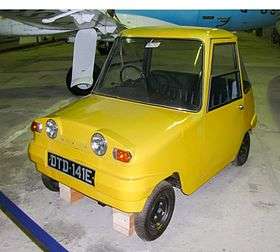Scottish Aviation Scamp
The Scottish Aviation Scamp is a small concept electric city car that was designed between 1964 and 1966 by Scottish Aviation.
| Scottish Aviation Scamp | |
|---|---|
 | |
| Overview | |
| Manufacturer | Scottish Aviation |
| Production | 1965 12 units |
| Designer | Dr. W.G. Watson[1] |
| Body and chassis | |
| Body style | Microcar |
| Layout | Rear-wheel drive |
| Powertrain | |
| Engine | 4 48-volt batteries 2 electric motors[1] |
| Dimensions | |
| Length | 84 in (2,134 mm)[1] |
| Width | 46 in (1,168 mm)[1] |
A prototype, known as "the farm cart" was built which showed promise, accelerating from a standstill to 30 mph (48 km/h) in ten seconds, giving a top speed of 36 mph (58 km/h) and a range of 18 miles (29 km) in urban conditions. In July 1965 negotiations took place between the Scottish Aviation and the Central Electricity Generating Board aimed at marketing the car through the area electricity boards' regional showrooms. The prototype was further developed with the addition of wood and aluminium bodywork and it was then registered for use on the road. It was successfully demonstrated in London and Bristol and received a great deal of publicity when on one occasion it was driven by the racing driver Stirling Moss. A further 12 cars were built for testing and the first of these went on show at the Ideal Home Exhibition in February 1967.[2]
The project began to run into difficulties because of an inability to resolve the uneconomic battery life of the Lucas Industries batteries available at the time. It was cancelled when major weaknesses in the car design were revealed by testing at the Motor Industry Research Association test track, subjected to the same tests as a conventional car, the suspension eventually broke and the car was claimed to be unroadworthy.[2]
Survivors
Of the 13 vehicles built (1 prototype, 12 production), only 5 are believed to survive:
- Scamp, registration DTD 141E, painted yellow, in the collections of National Museums Scotland.
- Scamp, registration LHT 147E, painted red, previously on display at Myreton Motor Museum, now displayed at Dundee Museum of Transport.
- Scamp, registration LHT 149E, painted white, displayed by the Scottish Motor Museum Trust in the entrance hall of Lomond Galleries retail outlet, formerly the Argyll Motor Works in Alexandria, West Dunbartonshire.
- Scamp, registration LHT 150E, painted white, in private ownership.
- Scamp, registration OSD 697H, painted white, in private ownership.
See also
References
| Wikimedia Commons has media related to Scottish Aviation cars. |
- Carr, Richard (1 July 1966). "In search of the town car". Design. Council of Industrial Design (211): 29–37.
- Dodds, Alastair. Making Cars. Scotland's Past In Action. National Museums of Scotland. pp. 63–65. ISBN 0-948636-81-5.